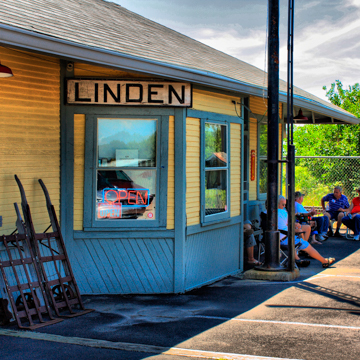You are here
Linden Depot Museum
The Chicago, Indianapolis, and Louisville Railroad, later more famously known as the Monon, was completed in 1852, linking Lake Michigan with the Ohio River. Platted along its north-south route was the town of Linden, Indiana. A gabled wooden station was erected there to serve the line. By the end of the nineteenth century, when the Toledo, St. Louis and Western Railroad, commonly known as the Clover Leaf, passed through Linden on its east-west route from Toledo, Ohio, to St. Louis, Missouri, the railroad station was moved a few blocks north to serve both lines. Sited diagonally on the southeast corner of the Monon–Clover Leaf crossing, this original station was destroyed by fire in early 1907. Two Clover Leaf cabooses were temporarily pressed into service as waiting stations while Monon and Clover Leaf worked out details for jointly constructing a new passenger depot and freight depot. The freight depot was completed in 1908 at the southwest corner of the crossing, and the passenger depot was erected the following year in the same location as the previous structure.
The passenger depot served both railroads with separate offices and a joint waiting room. The L-shaped, wood-framed building with a shallow hipped roof rests on a concrete foundation. The exterior has diagonal sheathing on the lower four feet and clapboard above to the broad eaves, which extend five feet all the way around the building. Each of the main facades, west and north, faces its respective railroad and features a bay window. The interior contains a large common waiting room in the northwest corner of the building. It is not quite square because the Clover Leaf tracks crossed the Monon at an angle, and the building’s northwest corner is at an eighty-degree angle. To the east is the Clover Leaf (later Nickel Plate) office, with a baggage room behind it. Similarly, to the south is the Monon office and baggage room. To the southeast was a small private waiting room that is now a restroom. The interior is largely intact, with six-panel doors and a molded cornice; both ticket windows feature simple wooden countertops supported by scroll brackets.
The Nickel Plate Railroad bought the Clover Leaf in 1922 and the shared depot arrangement continued. Freight service began to decline after the 1920s, with more and more shipping taken over by trucks, and the freight depot was demolished in 1960. Passenger service on the troubled Nickel Plate was discontinued in 1957; the company later merged with the Norfolk and Western in 1964. Further mergers did not save this line, and the tracks were removed in the late 1980s. Monon discontinued passenger service to Linden in 1964. The loss of passengers and most freight—and finally, even the mail—resulted in the closure of the depot in 1972. At that point, CSX took over the Monon tracks.
The citizens of Linden and the surrounding Madison Township formed a not-for-profit historical society to save the depot, ultimately restoring it in 1990. Three years later, the restored depot was reopened as the Linden Depot Museum. It is now the only railroad-related building that survives in the town, and, more significantly, is the last junction depot in the state of Indiana.
References
Burkle, Linda, “Linden Depot,” Montgomery County, Indiana. National Register of Historic Places Registration Form, 1991. National Park Service, U.S. Department of the Interior, Washington, D.C.
“Linden Depot Museum History.” Historic Linden Depot Museum. Accessed April 7, 2016. http://lindendepotmuseum.org/.
Parker, Francis H. Indiana Railroad Depots; A Threatened Heritage. Muncie, IN: Ball State University, 1989.
Writing Credits
If SAH Archipedia has been useful to you, please consider supporting it.
SAH Archipedia tells the story of the United States through its buildings, landscapes, and cities. This freely available resource empowers the public with authoritative knowledge that deepens their understanding and appreciation of the built environment. But the Society of Architectural Historians, which created SAH Archipedia with University of Virginia Press, needs your support to maintain the high-caliber research, writing, photography, cartography, editing, design, and programming that make SAH Archipedia a trusted online resource available to all who value the history of place, heritage tourism, and learning.

